Ice–Water Interfacial SERS/SEIRAS Reveals Novel Antifreeze Peptide Icing Inhibition Dynamics at the Molecular Level
IF 9.1
1区 材料科学
Q1 CHEMISTRY, MULTIDISCIPLINARY
引用次数: 0
Abstract
Unravelling ice–water interface water structure evolution is essential for understanding ice growth, but interfacial water is notoriously difficult to probe. We developed a Cryo-Raman/Infrared interaction profiling (CRIP/CIIP) technique to establish molecule-level correlations between ice growth and interfacial water structures. Antifreeze oligopeptides were localized on Au/Ag nanocubes (NCs) through mercaptobenzoic linker/Raman tags. Findings decrypt that the interfacial water structure is directly correlated to the ice recrystallization inhibition (IRI) activity of oligopeptides on NCs. With increasing density of oligopeptides, interfacial water is gradually subjected to a transition from 4-coordinated hydrogen-bonded water (4-HB·H2O) to 2-HB·H2O and π-hydrogen bond water (π-HB·H2O). This study finds π-HB·H2O acting as a new anti-icing force, with implications for designing IRI-active materials. Our CRIP technique enables the rapid recognition of IRI-active materials through benzene ring conformation allostery on NCs, establishing a general molecular strategy for screening antifreeze materials.

冰水界面SERS/SEIRAS在分子水平上揭示了新的抗冻肽结冰抑制动力学
解开冰-水界面水结构的演化对于理解冰的生长是必不可少的,但界面水是出了名的难以探测。我们开发了一种低温拉曼/红外相互作用分析(CRIP/CIIP)技术来建立冰生长和界面水结构之间的分子水平相关性。通过巯基苯甲酸连接剂/拉曼标签将抗冻寡肽定位在Au/Ag纳米立方(NCs)上。研究结果表明,界面水结构与NCs上寡肽的冰重结晶抑制(IRI)活性直接相关。随着寡肽密度的增加,界面水由4-配位氢键水(4-HB·H2O)逐渐过渡到2-HB·H2O和π-氢键水(π-HB·H2O)。本研究发现π-HB·H2O作为一种新的抗冰力,对iri活性材料的设计具有指导意义。我们的CRIP技术能够通过NCs上的苯环构象变构来快速识别iri活性物质,建立了一种筛选防冻材料的一般分子策略。
本文章由计算机程序翻译,如有差异,请以英文原文为准。
求助全文
约1分钟内获得全文
求助全文
来源期刊

Nano Letters
工程技术-材料科学:综合
CiteScore
16.80
自引率
2.80%
发文量
1182
审稿时长
1.4 months
期刊介绍:
Nano Letters serves as a dynamic platform for promptly disseminating original results in fundamental, applied, and emerging research across all facets of nanoscience and nanotechnology. A pivotal criterion for inclusion within Nano Letters is the convergence of at least two different areas or disciplines, ensuring a rich interdisciplinary scope. The journal is dedicated to fostering exploration in diverse areas, including:
- Experimental and theoretical findings on physical, chemical, and biological phenomena at the nanoscale
- Synthesis, characterization, and processing of organic, inorganic, polymer, and hybrid nanomaterials through physical, chemical, and biological methodologies
- Modeling and simulation of synthetic, assembly, and interaction processes
- Realization of integrated nanostructures and nano-engineered devices exhibiting advanced performance
- Applications of nanoscale materials in living and environmental systems
Nano Letters is committed to advancing and showcasing groundbreaking research that intersects various domains, fostering innovation and collaboration in the ever-evolving field of nanoscience and nanotechnology.
 求助内容:
求助内容: 应助结果提醒方式:
应助结果提醒方式:


